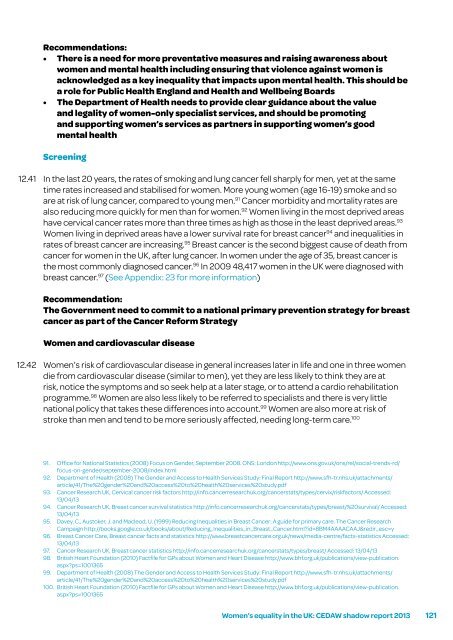Women’s equality in the UK – A health check
Women’s equality in the UK – A health check
Women’s equality in the UK – A health check
You also want an ePaper? Increase the reach of your titles
YUMPU automatically turns print PDFs into web optimized ePapers that Google loves.
12.41<br />
12.42<br />
Recommendations:<br />
• There is a need for more preventative measures and rais<strong>in</strong>g awareness about<br />
women and mental <strong>health</strong> <strong>in</strong>clud<strong>in</strong>g ensur<strong>in</strong>g that violence aga<strong>in</strong>st women is<br />
acknowledged as a key <strong>in</strong><strong>equality</strong> that impacts upon mental <strong>health</strong>. This should be<br />
a role for Public Health England and Health and Wellbe<strong>in</strong>g Boards<br />
• The Department of Health needs to provide clear guidance about <strong>the</strong> value<br />
and legality of women-only specialist services, and should be promot<strong>in</strong>g<br />
and support<strong>in</strong>g women’s services as partners <strong>in</strong> support<strong>in</strong>g women’s good<br />
mental <strong>health</strong><br />
Screen<strong>in</strong>g<br />
In <strong>the</strong> last 20 years, <strong>the</strong> rates of smok<strong>in</strong>g and lung cancer fell sharply for men, yet at <strong>the</strong> same<br />
time rates <strong>in</strong>creased and stabilised for women. More young women (age 16-19) smoke and so<br />
are at risk of lung cancer, compared to young men. 91 Cancer morbidity and mortality rates are<br />
also reduc<strong>in</strong>g more quickly for men than for women. 92 Women liv<strong>in</strong>g <strong>in</strong> <strong>the</strong> most deprived areas<br />
have cervical cancer rates more than three times as high as those <strong>in</strong> <strong>the</strong> least deprived areas. 93<br />
Women liv<strong>in</strong>g <strong>in</strong> deprived areas have a lower survival rate for breast cancer 94 and <strong>in</strong>equalities <strong>in</strong><br />
rates of breast cancer are <strong>in</strong>creas<strong>in</strong>g. 95 Breast cancer is <strong>the</strong> second biggest cause of death from<br />
cancer for women <strong>in</strong> <strong>the</strong> <strong>UK</strong>, after lung cancer. In women under <strong>the</strong> age of 35, breast cancer is<br />
<strong>the</strong> most commonly diagnosed cancer. 96 In 2009 48,417 women <strong>in</strong> <strong>the</strong> <strong>UK</strong> were diagnosed with<br />
breast cancer. 97 (See Appendix: 23 for more <strong>in</strong>formation)<br />
Recommendation:<br />
The Government need to commit to a national primary prevention strategy for breast<br />
cancer as part of <strong>the</strong> Cancer Reform Strategy<br />
Women and cardiovascular disease<br />
<strong>Women’s</strong> risk of cardiovascular disease <strong>in</strong> general <strong>in</strong>creases later <strong>in</strong> life and one <strong>in</strong> three women<br />
die from cardiovascular disease (similar to men), yet <strong>the</strong>y are less likely to th<strong>in</strong>k <strong>the</strong>y are at<br />
risk, notice <strong>the</strong> symptoms and so seek help at a later stage, or to attend a cardio rehabilitation<br />
programme. 98 Women are also less likely to be referred to specialists and <strong>the</strong>re is very little<br />
national policy that takes <strong>the</strong>se differences <strong>in</strong>to account. 99 Women are also more at risk of<br />
stroke than men and tend to be more seriously affected, need<strong>in</strong>g long-term care. 100<br />
91. Office for National Statistics (2008) Focus on Gender, September 2008. ONS: London http://www.ons.gov.uk/ons/rel/social-trends-rd/<br />
focus-on-gender/september-2008/<strong>in</strong>dex.html<br />
92. Department of Health (2008) The Gender and Access to Health Services Study: F<strong>in</strong>al Report http://www.sfh-tr.nhs.uk/attachments/<br />
article/41/The%20gender%20and%20access%20to%20<strong>health</strong>%20services%20study.pdf<br />
93. Cancer Research <strong>UK</strong>, Cervical cancer risk factors http://<strong>in</strong>fo.cancerresearchuk.org/cancerstats/types/cervix/riskfactors/ Accessed:<br />
13/04/13<br />
94. Cancer Research <strong>UK</strong>, Breast cancer survival statistics http://<strong>in</strong>fo.cancerresearchuk.org/cancerstats/types/breast/%20survival/ Accessed:<br />
13/04/13<br />
95. Davey. C., Austoker, J. and Macleod, U. (1999) Reduc<strong>in</strong>g Inequalities <strong>in</strong> Breast Cancer: A guide for primary care. The Cancer Research<br />
Campaign http://books.google.co.uk/books/about/Reduc<strong>in</strong>g_Inequalities_<strong>in</strong>_Breast_Cancer.html?id=8BM4AAAACAAJ&redir_esc=y<br />
96. Breast Cancer Care, Breast cancer facts and statistics http://www.breastcancercare.org.uk/news/media-centre/facts-statistics Accessed:<br />
13/04/13<br />
97. Cancer Research <strong>UK</strong>, Breast cancer statistics http://<strong>in</strong>fo.cancerresearchuk.org/cancerstats/types/breast/ Accessed: 13/04/13<br />
98. British Heart Foundation (2010) Factfile for GPs about Women and Heart Disease http://www.bhf.org.uk/publications/view-publication.<br />
aspx?ps=1001365<br />
99. Department of Health (2008) The Gender and Access to Health Services Study: F<strong>in</strong>al Report http://www.sfh-tr.nhs.uk/attachments/<br />
article/41/The%20gender%20and%20access%20to%20<strong>health</strong>%20services%20study.pdf<br />
100. British Heart Foundation (2010) Factfile for GPs about Women and Heart Disease http://www.bhf.org.uk/publications/view-publication.<br />
aspx?ps=1001365<br />
<strong>Women’s</strong> <strong>equality</strong> <strong>in</strong> <strong>the</strong> <strong>UK</strong>: CEDAW shadow report 2013 121


